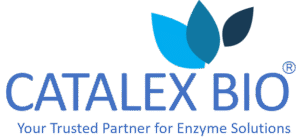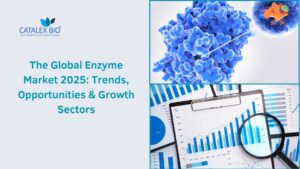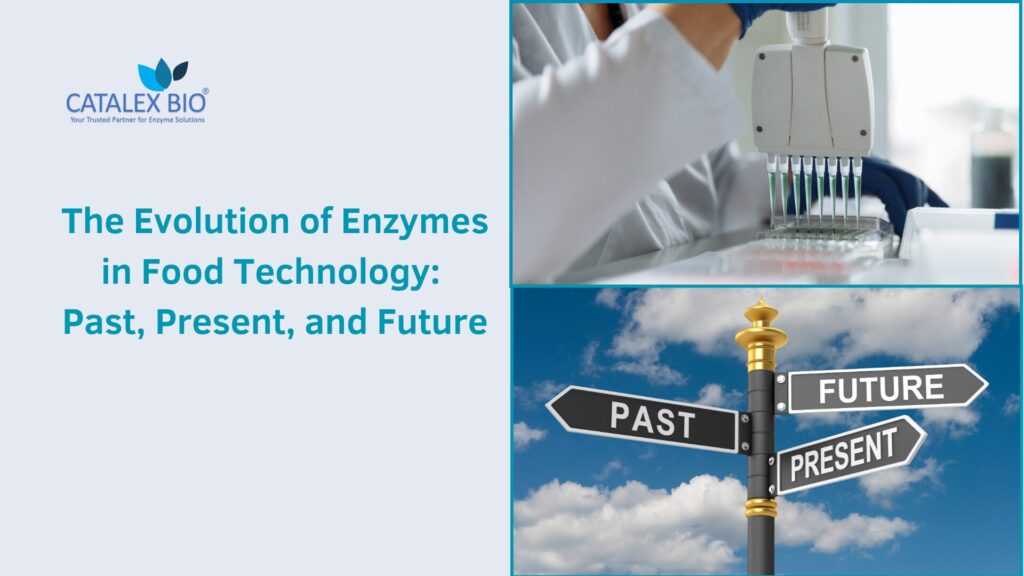Executive Summary
The enzyme industry enters 2025 with steady mid-single to high-single-digit growth, propelled by sustainability mandates, efficiency gains in manufacturing, and rapid advances in enzyme engineering and biocatalysis. Industrial enzymes are projected in the ~$8–9B range in 2025 and tracking toward $12B by 2030 (≈6–7% CAGR), with food & beverage, detergents, animal nutrition, and pharma/biocatalysis as the strongest demand centers.
At Catalex Bio, we closely follow these global shifts to align our innovation pipeline and partnerships with the industries that will benefit most from enzyme-driven transformation.
Market Snapshot (2025)
- Industrial enzymes: ~$8.4–8.8B (global), ~6–7% CAGR to 2030.
- Food enzymes: ~$1.2–3.1B with ~5–6% CAGR (range varies by methodology). Carbohydrases lead by share.
- Detergent enzymes: ~$1.5–2.3B, ~6–7% CAGR through 2030–2032.
- Specialty/pharma & diagnostics enzymes: 8%+ CAGR near term.
- Biocatalysis in drug manufacturing: ~$1.7B (2024), ~7–8% CAGR (2025–2035).
Five Demand Drivers to Watch
- Sustainability & regulation – Enzymes enable lower temperature, less water/chemicals, and better yields, aligning with ESG targets and green-chemistry rules.
- Biocatalysis mainstreaming – Wider adoption in pharma and fine chemicals for chiral selectivity, milder conditions, and shorter routes.
- Food system transition – Clean-label processing, plant-based foods, fermentation-enabled ingredients, and waste valorization.
- Cold-wash & concentrated detergents – Energy-saving wash cycles push multi-enzyme blends with greater low-temp activity.
- AI-assisted enzyme design – Faster discovery and multi-enzyme cascades (immobilization, flow biocatalysis) moving from R&D to production.
Growth Sectors
- Food & Beverage Processing
- Baking (amylases, xylanases, lipases), dairy (lactase, rennet aids), brewing/juice (pectinases, glucanases).
- Clean-label texturizing and sugar-reduction keep demand resilient; carbohydrases lead category share.
- Home & Fabric Care (Detergents)
- Enzymes (protease, amylase, lipase, mannanase, cellulase) underpin cold-wash, short cycles, and low-alkaline formulations; growth ~6–7% CAGR.
- Animal Nutrition
- Pharma & Fine Chemicals (Biocatalysis)
- Enzymatic routes for APIs/intermediates cut steps and waste; 7–8% CAGR outlook to 2035.
- Bio-industrials
- Bioethanol, textiles (biopolishing, desizing), pulp & paper (deinking, bleaching aids), leather (bating, dehairing), and wastewater treatment — all benefiting from energy/water savings.
- Fermentation-enabled & Precision-fermented Ingredients
- Rapid pipeline growth in functional proteins (caseins, whey, egg, collagen analogs) and enabling enzymes; market projected to scale sharply this decade.
Technology Trends Shaping Competitiveness
- Directed evolution + AI/ML – Shorter design cycles, improved thermostability, and broader substrate scope.
- Immobilization & flow reactors – Higher space–time yields and easier enzyme recovery.
- Formulation innovation – Co-granulation, encapsulation for bleach and oxidant stability in detergents; multi-enzyme blends optimized for specific soils/fabrics/water hardness.
- Precision fermentation scale-up – Host selection, cost of media, and downstream processing are key levers for cost parity in novel proteins.
Regional Outlook
- North America & Europe – High penetration in detergents, food processing, and pharma; strong IP and regulatory pathways.
- Asia-Pacific – Fastest growth led by China and India in food processing, textiles, and feed, supported by manufacturing scale-up and domestic champions.
Opportunities for Brands & Suppliers in 2025
- Decarbonization partnerships – Quantify energy/water/chemical savings per ton of output and integrate into ESG reporting.
- Segment-specific enzyme kits – Pre-optimized blends for cold-wash detergents, high-fiber feed, or high-gravity brewing.
- Co-development with F&B leaders – Sugar-reduction, texture, and fiber enhancement supported by carbohydrases and proteases.
- Biocatalysis CDMO services – Route scouting, enzyme engineering, and immobilized process packages for pharma/fine-chem customers.
- Precision-fermented ingredient enablement – Supply of process enzymes and downstream solutions to PF players scaling caseins, egg proteins, and collagen.
Risks & Watch-outs
- Feedstock & energy volatility may squeeze fermentation margins; diversified substrates and yield optimization are key.
- Regulatory and labeling hurdles in food applications (GRAS/EFSA) must be anticipated early.
- IP density in engineered variants demands careful freedom-to-operate checks.
- Scale-up gaps in precision fermentation — contract manufacturing and downstream processing costs remain limiting factors.
2025–2030 Outlook
Expect sustained 6–7% CAGR for industrial enzymes into 2030, with outsized gains in detergents, biocatalysis, and precision-fermented value chains. Companies that combine application expertise, data-driven ROI, and co-development models will capture premium pricing and build durable partnerships.
At Catalex Bio, we see these opportunities as central to how we innovate and collaborate with customers across industries. Partner with Catalex Bio to harness the power of enzymes for your industry.
Reach out to us explore customized enzyme and probiotic solutions for your business.



Pingback: How Enzymes Replace Harsh Chemicals in Industry | Catalex Bio